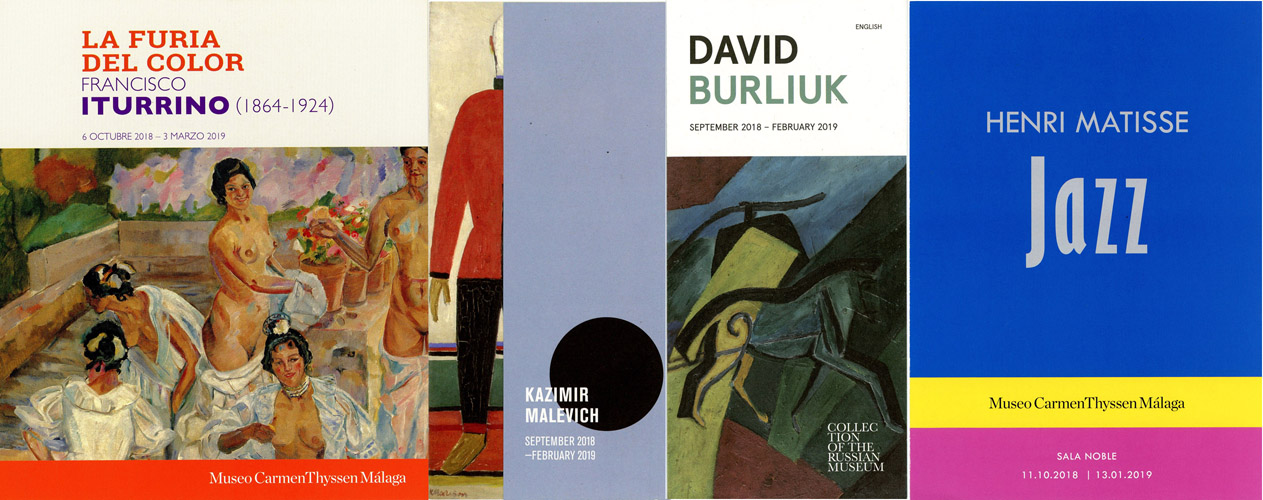|
KAZIMIR MALEVICH.
DAVID BURLIUK
THE FURY OF COLOUR: FRANCISCO ITURRINO (1864-1924)
HENRI MATISSE: JAZZ
PICASSO’S SOUTH: ANDALUSIAN REFERENCES
The
But there was more to Malevich than that one iconic work, and the
exhibition follows him through his career as he touched on
Impressionism, Cézannism, and Futurism. His influence was profound,
not only in terms of the effect his paintings, but also because of
his positions within various artistic institutions. But that was a
role which may have led to him being suspected of “bourgeois
tendencies”, among other things, by the new breed of bureaucrats
determining what was acceptable as Stalin’s grip on power increased
and Socialist Realism became the dominant mode in art. Malevich was
imprisoned for a time in the early-1930s, bizarrely on a charge of
spying, and one wonders what might have happened to him had he not
died in 1935. There is some evidence discernible in his work from
the 1930s to indicate that he played down its experimental aspects
and adopted a less-controversial stance.
I doubt that David Burliuk is a familiar name, other than perhaps
among a few specialists in twentieth-century Russian art. He was
born in 1882, and has been called “the father of Russian Futurism”.
The
What is striking about Burliuk is that he seems to have involved
himself in almost every avant-garde artistic and literary movement
of his time, and he knew numerous painters and poets. He co-wrote,
with Mayakovsky, the manifesto, “A Slap in the Face of Public
Taste”, and performed as a poet, the aim being to provoke. It’s
difficult to arrive at a fair assessment of his capabilities as an
artist from the limited number of works in the exhibition, though
it’s not hard to realise that he probably made a wise move when he
went to
It’s worth noting that the
Reviving the reputations of artists is something that needs to be
done on a regular basis, and it would seem to be the intention of
the exhibition of Francisco Iturrino’s paintings at the Museo Carmen
Thyssen. Born in
Iturrino also had a liking for large paintings of female nudes.
While they’re eye-catching in some ways, they seemed to me to be
mostly empty of any positive passion. The women appear to lack any
real character, despite in certain cases (a group in a bath house,
for example) being supposedly cheerful and active. Iturrino is
claimed as “a highly original artist”, but I didn’t understand that
from what I saw. His work is not unattractive in general, but it
didn’t comes across as having any great individuality in terms of
breaking new ground. This may be a case of a modestly talented
painter being accorded more attention than he deserves.
Henri Matisse’s “Jazz” sequence has a place in art history as an
example of how an elderly and ailing artist refused to stop creating
and produced “brightly coloured paper cut-outs”, his stated
intention being to “draw with scissors”. I’ve seen the sequence more
than once, but this viewing finally convinced me of its qualities.
Perhaps it was the straightforward way it was mounted on the walls,
and perhaps even because a tasteful piano could be heard playing
jazz in the background. I don’t usually agree with music being
played in galleries, but it proved appropriate here. Whatever,
something came together for me in a manner that hadn’t happened
before.
Picasso’s South: Andalusian References
places him firmly in the area that helped to shape him as an
artist. With a selection of his paintings ranging from his
early day in
|
